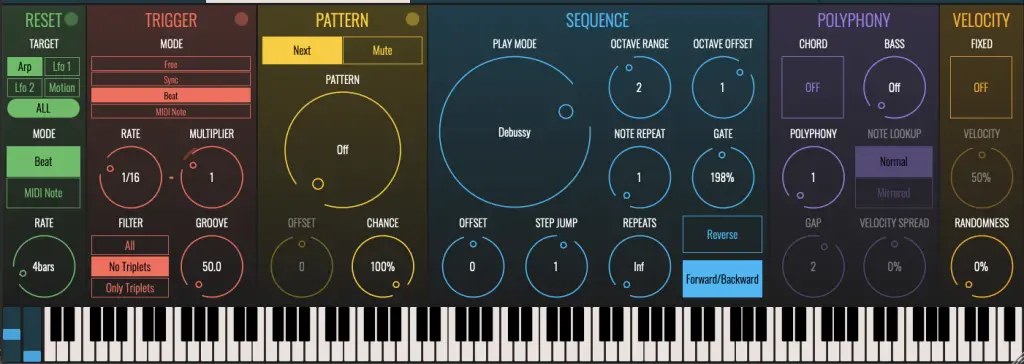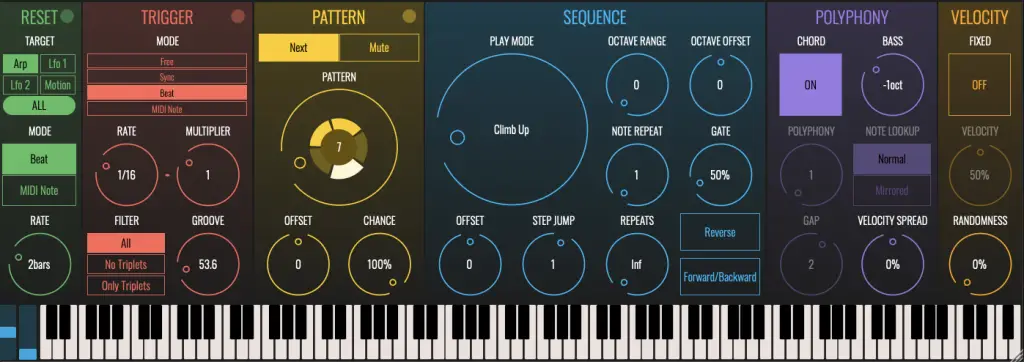Table of Contents
BLEASS Arpeggiator brings a fresh take on the arpeggiator concept by teaming up with Canblaster, a French producer known for his inventive rhythms and unique musical style. This collaboration elevates BLEASS’s plugin from a straightforward arpeggiator to a dynamic sequencing tool with remarkable depth.
One of the biggest gripes I have with arps is that they’re fairly one-dimensional, playing predictable patterns that have been used and reused pretty much since the dawn of synths. Sure, you have plugins like Cthulhu, but in my opinion that plugin has always felt like an interest overcorrection of my point above.
While arpeggiators have been around for decades, BLEASS’s version does more than cycle through notes. It combines classical mechanics with creative modulation, allowing producers to explore musical ideas that would usually require multiple plugins or complex setups.
In this review, we’ll break down BLEASS Arpeggiator’s capabilities, from its flexible polyrhythms to its straightforward user interface. This tool has an intuitive interface that fits into any producer’s workflow regardless of genre and skill level. By the end, you’ll understand how BLEASS Arpeggiator opens up fresh possibilities for arpeggiated sequences and whether it could bring new life to your setup.
Overview of Key Features

BLEASS Arpeggiator respects traditional arpeggiator design while introducing modern elements like polyrhythms and polyphony that make it unique. Most classic arpeggiators repeat simple note patterns up and down, but BLEASS goes further, letting users build complex rhythmic layers across multiple octaves. With these features, BLEASS Arpeggiator creates sick and pro-sounding patterns that can carry a track or add subtle, dynamic layers to the background of whatever you’re cooking up in the studio.
Polyrhythms and polyphony level up BLEASS Arpeggiator’s functionality and use cases as well. Polyrhythms, which involve overlapping rhythms that cycle at different rates, allow for intricate sequences that shift and surprise. Meanwhile, polyphony lets the arpeggiator handle chords, cycling between notes within a chord to create pretty dope textures, both harmnically and sonically. BLEASS has made these elements dang easy to use too, so even producers unfamiliar with advanced sequencing can explore layered, evolving sounds.
BLEASS Arpeggiator also boasts a broad library of patterns with 62 rhythmic options.
These patterns cover everything from classic up-and-down arpeggios to more experimental and randomized styles. With so many options, the plugin caters to a variety of genres and production styles, from electronic and hip-hop to cinematic soundscapes. This flexibility makes it easy to find a pattern that fits, whether you’re layering textures for a dance track or crafting atmospheric sounds for film.
User Interface & Workflow
The ‘RP Jeta Board’ is the main interface in BLEASS Arpeggiator, where users shape the rhythm and order of their arpeggios. It includes standard arpeggiator controls like rate, direction, and octave range, so producers will feel at home immediately. But BLEASS has added a twist, incorporating unique play modes like “walk up,” “climb up,” and patterns inspired by classic music, such as Debussy and Morricone.

This variety offers a creative playground for those looking to step beyond the basics without sacrificing usability or creating patterns that are so wild and off-kilter that they make “music” that nobody wants to listen to.
The Performance Board and XY modulation pads are one of its better features in BLEASS Arpeggiator. The Performance Board integrates well with MIDI controllers, offering real-time parameter control through an XY pad, which allows users to assign modulation to both axes. This setup brings a tactile dimension to production, especially for those working on iOS devices or in mobile setups. I’m not usually a fan of iPad-based plugins and I’ll admit I never tried the iPad version, but it’s at least worth mentioning that it’s an option!

Whether you’re tweaking parameters on a tablet or controlling modulation in a live setting, the Performance Board makes BLEASS Arpeggiator adaptable and engaging.
BLEASS has also included two LFOs and a Motion Sequencer to add further complexity and movement to your sequences. Each LFO can be linked to nearly any parameter within the arpeggiator, creating dynamic and evolving soundscapes. The Motion Sequencer is particularly impressive, offering a way to modulate arpeggiator settings in time with the beat. This feature is perfect for producers looking to add more detail and variation to their arpeggios, allowing each sequence to change subtly as it repeats, keeping listeners engaged.

Integration & Compatibility
BLEASS Arpeggiator is compatible across iOS, macOS, and Windows, making it versatile for producers working on a variety of platforms. It’s available as AUv3 for iOS and VST3, AU, and AAX for desktop, with full compatibility on M1 and M2 Macs. This cross-platform functionality means BLEASS can serve a wide audience, from mobile producers working on iPads to studio-based musicians using advanced desktop setups. Whether you’re in a fully equipped studio or working on the go, BLEASS’s platform flexibility makes it a solid choice.
Installation is quick and straightforward, especially on iOS where AUv3 plugins integrate quickly and easily into apps like AUM. One tip for iOS users: use an official Apple brand adapter when connecting BLEASS Arpeggiator with external gear. This ensures reliable connectivity, especially when paired with MIDI hardware. BLEASS has clearly put effort into making this plugin user-friendly across devices, making it accessible regardless of your technical expertise.
Hands-On Experience
Starting with BLEASS Arpeggiator is straightforward, even if you’re not familiar with advanced arpeggio settings. The plugin provides preset patterns that help you get a feel for its capabilities, and you can adjust the step count and polyrhythms to create more complex sequences. BLEASS’s layout makes it easy to experiment without getting lost in the details, so you can quickly move from basic patterns to intricate rhythmic structures that add depth to your tracks.

The internal synthesizer, a double FM synth, is a convenient feature that allows for quick sound design without needing to route MIDI to another instrument. While it’s not designed to replace a full-featured synth, the internal synth is surprisingly capable, making it a great option for testing out ideas or adding layers to a mix. This synth’s straightforward controls make it ideal for sketching out ideas quickly, whether you’re working on a track from scratch or building up an existing composition.
BLEASS Arpeggiator also shines in live performance settings. The Performance Board’s mod wheel and XY modulation provide intuitive ways to manipulate parameters on the fly, letting you shape your sound in real-time. For performers, this feature means that BLEASS can be more than a static pattern generator; it becomes an instrument that responds to touch, making it ideal for producers who want to bring a personal touch to their live shows.

Strengths & Weaknesses
BLEASS Arpeggiator’s X-factor is in its flexibility and the advanced features it brings to a familiar plugin category. Its polyrhythmic capabilities and polyphony options make it one of the best options available these days among other arpeggiators – not that it’s an overly crowded place – while the Motion Sequencer adds a unique way to animate and control patterns over time. This tool isn’t limited to simple, repetitive arpeggios—it offers depth and adaptability that will appeal to creative producers and sound designers.
But there are a few drawbacks to consider…
BLEASS Arpeggiator has a learning curve, especially if you want to use advanced features like LFO linking and the Motion Sequencer. For users who are new to modulation-heavy tools, it might take some practice to get the most out of these options. Additionally, the plugin doesn’t come with an extensive preset library, which could be a drawback for those who prefer ready-made options over custom tweaking.
Who Is This For?
BLEASS Arpeggiator is killer for producers who want more control over their arpeggios, from sound designers interested in complex modulations to live performers seeking expressive, interactive tools. Its intuitive interface and deep feature set make it accessible to both beginners and experienced users.
BLEASS is a versatile and powerful option for electronic music producers, cinematic sound designers, and even live performers looking for a dynamic arpeggiator. The plugin is built for those willing to explore its potential, but it’s also easy enough to use for quick, effective results.
It’s a no-brainer for EDM and dances music producers, too, since arp lines are so part and parcel with almost every genre in dance music, but 90% of arps out there fall just short enough to make me personally just rather click in notes with my mouse.
Final Thoughts
BLEASS Arpeggiator redefines what an arpeggiator can accomplish, bridging the gap between a classic arpeggio plugin and a modern pattern sequencer. Its intuitive design allows users to explore complex modulation and sequencing options without feeling overwhelmed, while the inclusion of unique features like the Motion Sequencer and LFO control make it versatile enough for a variety of music genres and production styles. BLEASS has managed to balance complexity and ease of use, making this plugin a valuable tool for any producer’s setup.
For those looking to level up their arpeggio game with a plugin that pushes creativity above all other things, BLEASS Arpeggiator is an amazing choice. At a price of $29, it offers great value for money, especially considering the features and cross-platform compatibility. BLEASS has delivered a tool that brings both depth and practicality to arpeggiated sequences, making it well worth a look for producers who want more from their arpeggiator.
The post BLEASS Arpeggiator Review: A Creative Arp That Goes Beyond Just Simple Riffs appeared first on Magnetic Magazine.



